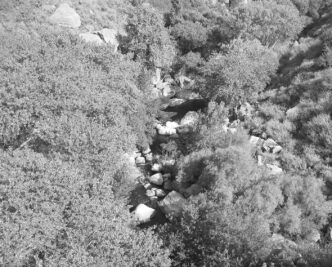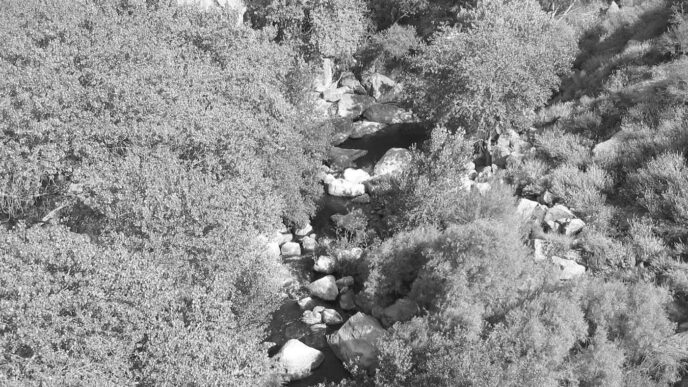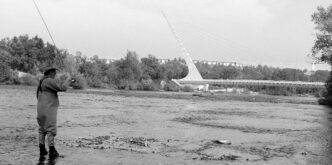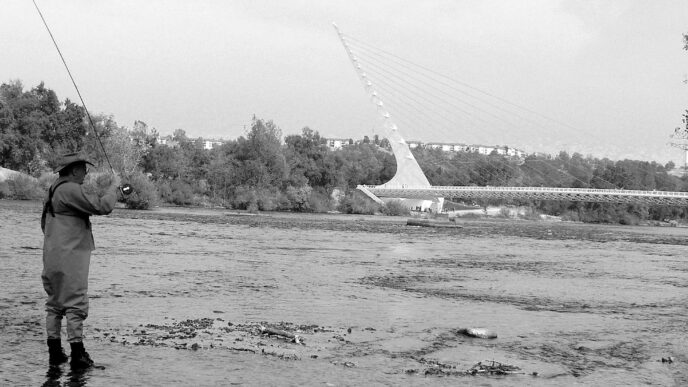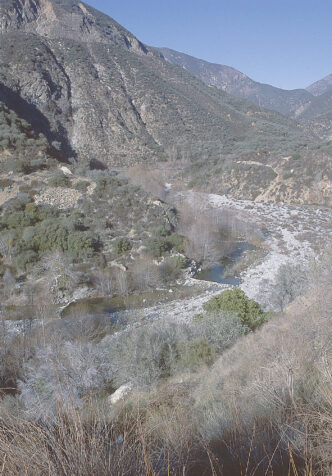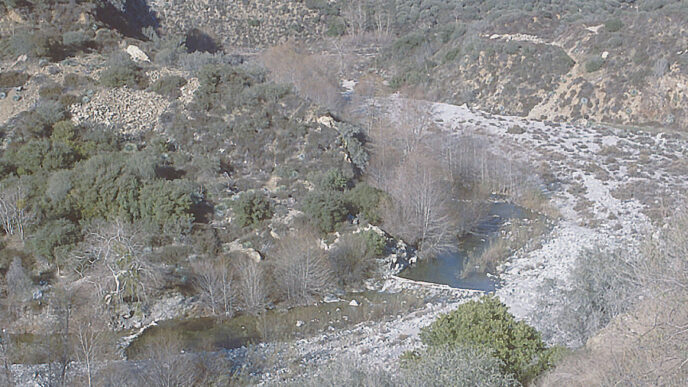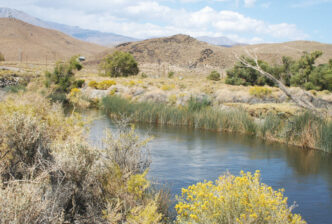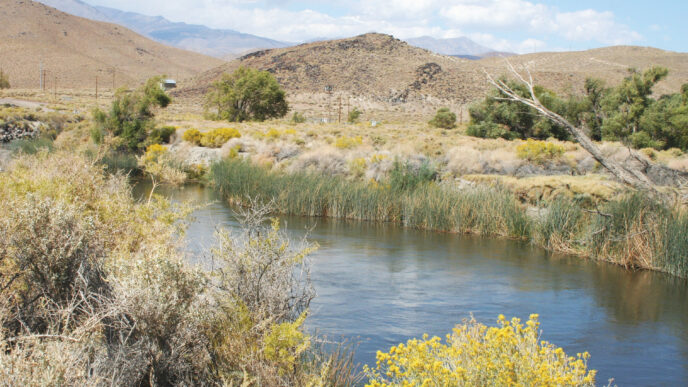By almost any measure, the lower Sacramento River from Redding to Red Bluff is California’s number-one wild-trout fishery. Whether ranked in terms of the number of fish caught, the number of guided trips, the number of user days, the number of fish caught per hour, or the size of fish caught, the lower Sac is at or near the top of the list. Due to the quality of the fishing and the river’s relative proximity to urban areas and a preponderance of knowledgeable guides, the lower Sac has also served as the place where thousands of people were introduced to fly fishing.
If asked to describe fly fishing, many of these beginners would tell you that it involves flopping three flies and some weights suspended by a bobber from one side of the boat to the other. While that limited notion of fly fishing may not be what we would want to see in fly fishing’s Wikipedia entry, it brings home a couple of points. The first is that fly fishing is great because it means a lot of different things to a lot of different people. One trout angler may enjoy casting a yellow Humpy on a small stream, while another prefers jigging streamers in a concretelined canal. The second point is that bobber fishing is extremely effective. The typical beginner who has just fished the lower Sac with a bobber all day would probably go on to tell you, “It was so much fun! I’ve never caught so many trout in one day!”
Anyone who has fished the lower Sac or any other large trout stream with a guide will be familiar with this technique. Attach a 3/4-inch Thingamabobber at the end of the butt section of your fly line. Then tie on anywhere from 6 to 9 feet of 3X tippet, followed by weights and either two or three nymphs at 16-inch intervals. The length of the tippet and the amount of weight change a lot, depending on the flow of the river. As the boat drifts, the angler casts out to one side about 25 feet. The rower moves the boat at the same speed as the bobber, and the angler mends the line to get a long, drag-free drift.
When you have the right flies and there is good communication between the person at the oars and the angler, this technique works incredibly well. There are many days when an angler hooks dozens of fish. The best thing about it from a guide’s perspective is that a newbie can catch a fish on his or her very first cast.
The ease and productivity of bobber fishing has some interesting consequences on the lower Sac. The water that works best with the bobber rig is four to eight feet deep, with a uniform current. It is possible to fish other water types successfully with this technique, especially with skilled anglers, but the most productive water for bobber fishing is a long run with moderate depth. The vast majority of drift boats stick to this water type, frequently back rowing to hit each good run more than once. So you can pretty much divvy up the lower Sac into two water types: the long runs with moderate depth (we’ll call this the “bobber-bashed boat highway”) and all the other water.
Savor that phrase: “all the other water.” Because bobber fishing is so successful on the lower Sac that almost everybody does it and does it the same way on the same water, that leaves a big chunk of the river that doesn’t get fished very much. Once you’re out of the bobber-bashed boat highway, you can safely assume that you’re casting to fish that don’t see very many flies. These neglected water types include shallow riffles and runs, riprap-lined banks, tailouts of long runs, flats with aquatic weed beds, and back eddies. These water types can be productively fished using a wide variety of techniques that do not involve using a bobber. You can also fish some of that prime bobber water with different techniques that are surprisingly fun and effective.
You can spend a bobber-free day on the lower Sac and never get out of your boat — and yes, much fly fishing on the lower Sac is boat fishing, given the size of the river. Some boat-friendly techniques include headhunting rising fish with dry flies, side-drifting nymphs, and swinging nymphs or stripping streamers on a sinking line. If you get out of the boat and wade, you have even more options, including short-line nymphing and swinging flies with a light Spey rod.
Dry-Fly Fishing on the Lower Sac
The lower Sac is one of the most underrated dry-fly fisheries in California. When guiding, I’m always on the lookout for rising fish. Most days, I can find some good targets, even midday. The key on the lower Sac is to recognize that if you notice a fish rise in a certain spot, it is probably not alone, and usually there will be multiple rising fish in that area.
When you see a riser, stop and watch the area for about five minutes. Often, the fish are stealthy risers on the lower Sac. It can be difficult to see the rises if you’re in a moving boat. Once you’ve stopped, it’s much easier to see the rising fish. Once you have them marked, position yourself upstream and across from the fish. If you’re in a boat, you may need to stay well away from the fish. Some fish are very forgiving, but others will spook if you get within 60 feet. If you can get out and wade into position, the fish will usually let you get much closer. It’s common on the lower Sac to wade within 15 feet of a rising fish.
There are good hatches throughout the year that bring fish to the surface. Springtime hatches include March Browns, small black caddisflies, Callibaetis mayflies, Pale Morning Duns (PMDs), and a pinkish PMD called the Pink Albert. All of these bugs commonly hatch around midday on warm days from January to May. Starting around 11 A.M., be on the lookout for emerging insects and rising fish. In midsummer, the best midday hatches are a tan caddis and small Baetis mayflies. Summer evenings can be spectacular, with mixed hatches of mayflies and caddisflies. Late summer sees a Trico spinner fall on the lower river, caddisflies, and more smallish mayflies. September and October can have great midday hatches of caddisflies up to a size 12. During the fall and winter, the main midday dry-fly action is on small Baetis mayflies.
On any given day, the dry-fly fishing can be anywhere from nonexistent to fantastic on the lower Sac. I’ve had many days when we landed more fish on dries than on nymphs. Some of the best Trico spinner falls I’ve ever fished have been on the lower Sac. I’ve sight fished to 18-inch-plus rainbows slurping big caddisflies in a foot of water. Then there are the days when we fish nymphs all day long. Dry-fly fishing the lower Sac is all about confidence and patience. You need patience to watch a likely spot for five minutes and the confidence that another opportunity will present itself if you don’t see anything happen.

Side-Drifting Nymphs from a Boat
My introduction to side-drifting nymphs was on the upper Rogue River in Oregon. This technique is similar to side drifting with an indicator. The rigging involves a tapered leader about the length of the fly rod. You can use split shot or a heavily weighted fly to get down near the bottom. On the Rogue, most fly fishers who side-drift use a heavy Rubberlegs stonefly nymph trailed with a Glo Bug egg pattern. Side-drifting nymphs has always been productive for me on the Rogue for adult steelhead and half-pounders. If it works there, I reasoned, why wouldn’t it work on the lower Sac for trout?
It took only about 100 yards of side drifting to determine that this technique does in fact work on the lower Sac. I was fishing from the back of the boat while my wife, Katie, rowed through a riffle. A friend was in the front, fishing with a standard indicator rig. I made about three casts and was rewarded with a fat 12-inch rainbow on a size 16 Bird’s Nest. The best thing about this technique is that you are tight to the fish from the instant you feel the grab. There is none of the frantic hook setting, boat swiveling, and line stripping that accompanies a bobber hookup.
Like nymphing with an indicator from a moving boat, this is still very much a visual technique that demands a lot of coordination between the rower and the angler. The easiest and most effective presentation is to cast straight across the river and try to keep the boat moving at the same speed as the flies. Give the flies a little slack, so they can sink near the bottom, then keep the line tight by slowly stripping the line in. Keep your rod tip low. This is not a high-sticking presentation. Strip your line in just fast enough to avoid snagging the bottom. Once the flies get within 15 feet of the boat, cast it back out again.
It’s good to cast a little farther across the river than you would with a bobber. The reason for the longer cast is that in order to feel the grab, you have to bring the flies closer and closer to the boat. If you cast farther out, you’ll get a longer drift before the flies get too close to the boat, and you need to cast again. In general, I like to use a little more lead for a given spot than I would to fish with a bobber. Unlike a slack-line indicator presentation, in which the flies quickly sink near the bottom, the line is tighter with this technique, so it takes a little more lead to get down.
A bright-colored fly line or a line with a fluorescent tip is best for visibility. Detecting the grab is a combination of feeling it and watching the tip of the fly line for sudden movements. “Nymph” lines with brightly-colored tips were designed for fishing without an indicator. There isn’t much point in having three feet of highvis line at the end of your fly line if you’re just going to put a big fat orange bobber on there.
In certain water types, this side-drifting technique is almost as effective as using an indicator. It’s most effective in the shallower riffles, two to five feet deep with a uniform current. In this water type, it’s easy to get the fly or flies near the bottom. The fast water also results in some pretty aggressive strikes, which are easy to detect. One cool thing about this technique is that you can fish water of varying depths with the same rig. In shallow water, cast straight across and start retrieving the nymphs right away. In deeper water, cast a little more downstream and let the flies sink before starting the retrieve.
Spey Casting for Trout
A very enjoyable way to spend a day on the lower Sac is to swing nymphs with a light Spey rod. The lower Sac has tremendous opportunities for Spey rod enthusiasts. Even at flows up to 12,000 cubic feet per second, there are many great spots to wade. As the flows recede during the fall, winter, and spring, even more water opens up for the wading Spey caster.
A 5-weight Spey rod is a good choice for swinging flies for trout on the lower Sac. Mine is 12-1/2 feet long, and I match it with a 5/6-weight floating Scandi-style shooting head tipped with a 10-foot leader from a set of quick-change leaders that range from floating to fast sinking (I like a 3X tippet, with 4X for small flies). This rig is light and easy to cast all day long. With little exertion, I can deliver my fly over 80 feet. With a Spey rod and a strong pair of legs, you can cover a lot of water on the lower Sac. Many types of flies work well with a Spey rod there. You can fish the same nymph patterns that you would under a bobber. Micro Mayflies, S&M Nymphs, Fox Poopahs, Bird’s Nests, and Prince Nymphs work great. You can even fish a two-fly rig. Rubberlegs stonefly patterns can be good, but avoid any flies that have a tendency to spin and twist your leader, a tendency that the velocities generated by Spey rods exacerbate. My favorite fly to swing on the lower Sac is a natural or olive Bird’s Nest, size 10 to 14. As you go farther downstream (for example, toward Jellys Ferry and beyond) the fish dine on a wider variety of food items. Swinging a Zonker minnow or Woolly Bugger trailed with a Bird’s Nest can be deadly. A 3X tippet is usually all you need, but you might go down to 4X for the smaller flies. Since Spey casts are powerful and a bad cast can put a lot of stress on your terminal tackle, I discourage three-fly rigs and tippets lighter than 4X.
There are two main approaches when swinging flies on the lower Sac: traditional or nymph style. Traditional techniques involve casting 45 degrees downstream and swinging your fly across the currents. If you want to get down deep, you can use a fast-sinking leader (7 inch-per-second sink rate). If you want to fish near the surface, you can use a floating or intermediate leader. This technique works great when the fish are actively feeding in water less than four feet deep.
When the fish are in deeper water, especially during the midday hours, it pays to adjust your technique a little and mimic the nymph fisher. Ditch the sinking leader and put on an 8-to-10-foot leader with some split shot. Nothing gets a fly down like a little lead. If you really need to get down, use two or three 3/0 shot. Rig your nymphs as you would for bobber fishing. Put the first nymph about 16 inches from your weights and add a second nymph 16 inches from the first. Cast more across the flow or even slightly upstream. Try to give your flies a little slack so they have a chance to sink. The whole idea is to give the flies a dead drift of 20 to 30 feet before they begin to swing. Often, you’ll feel the line come tight on a fish just as the flies start their swing.
During the high flows of summertime, it can be challenging to find a place to wade where you can cast into deeper water. Focus on the riffles, especially riffles with pockets of deeper water. There are plenty of fish in the shallow riffles. If you don’t believe me, just stick around until the last hour of the day. A Spey rod is a trout catching machine during the prime time in the evening when the fish are rising all over the place. From one spot, you can cover a vast amount of water. It’s great fun to see fish rising and know that any fish within 100 feet better be careful! If you’re a Spey aficionado, the lower Sac is your playground.





